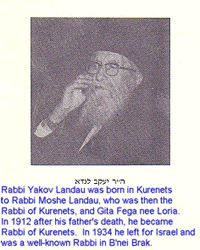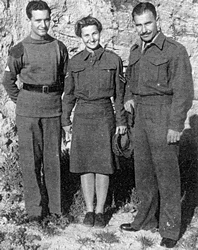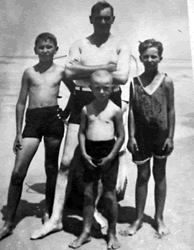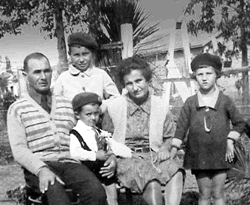City Panevezys
The building committee poses by the framework of the first house reconstructed by the AJDC on Col. Lehman St. (L-r) social worker Ram, 'kehile' president Rickly, Joseph Marcus, councilor Gurvich, Beregovsky, Rabinovich, Todes, attorney Landau.
#land-3:
Eliyahu, Chasia and Shmuel Landau as soldiers during the Second World
War
http://www.rishonim.org.il/rehovot/info/founder_show.aspx?id=82496
#land-4:
The Landau Family of Rehovot. From the right; Chasia, Muly and
Lucy with their father; Yosef. For more pictures go to;
http://www.nrg.historychannel.co.il/?cmd=photographers_gallery&member_id=2386
#land-5:
The Landau family with grandfather; Michael
Rehovot, 1935
For family tree go to;
http://www.rishonim.org.il/rehovot/info/founder_show.aspx?id=82489
#land-6:
The Landau Family of Rehovot.
On the right; Chasia (nee Landau) Perry. Chasia was the mother of Sefi
Z"L and Yonatan and Shlomo Perry. Next to Chjasia; her mother, Miryam,
Lucy, Muly and Yosef. For more pictures go to;
http://www.nrg.historychannel.co.il/?cmd=photographers_gallery&member_id=2386
#land-7
Aharon Landu
Born in Belarus in 1907
came to palestine in 1925 http://www.netanya-moreshet.org.il/show_item.asp?levelId=44133&itemId=2344&itemType=6000
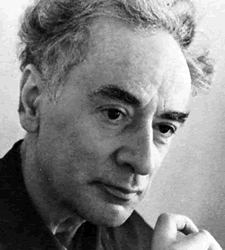
#land-17:
Lev Davidovich Landau
Soviet theoretical physicist, one of the founders of the quantum theory of condensed matter whose pioneering research in this field was recognized with the 1962 Nobel Prize for Physics.
Landau was a mathematical prodigy and enfant terrible. His schooling reflected the zigzags of radical educational reforms during the turbulent period following the Russian Revolution of 1917. Like many scientists of the first Soviet generation, Landau did not formally complete some educational stages, such as high school. He never wrote a doctoral thesis either, as academic degrees had been abolished and were not restored until 1934. He did complete the undergraduate course in physics at Leningrad State University, where he studied from 1924 to 1927. In 1934 Landau was granted a doctorate as an already established scholar.
While still a student, Landau published his first articles. A new theory of quantum mechanics appeared in Germany during those years, and the 20-year-old complained that he had arrived a little too late to take part in the great scientific revolution. By 1927 quantum mechanics was essentially completed, and physicists started working on its relativistic generalization and applications to solid-state and nuclear physics. Landau matured professionally in Yakov I. Frenkel's seminar at the Leningrad Physico-Technical Institute and then during his foreign trip of 1929–31. Supported by a Soviet stipend and a Rockefeller fellowship, he visited universities in Zürich, Copenhagen, and Cambridge, learning especially from physicists Wolfgang Pauli and Niels Bohr. In 1930 Landau pointed out a new effect resulting from the quantization of free electrons in crystals—the Landau diamagnetism, opposite to the spin paramagnetism earlier treated by Pauli. In a joint paper with physicist Rudolf Peierls, Landau argued for the need of yet another radical conceptual revolution in physics in order to resolve the mounting difficulties in relativistic quantum theory.
In 1932, soon after his return to the Soviet Union, Landau moved to the Ukrainian Physico-Technical Institute (UFTI) in Kharkov (now Kharkiv). Recently organized and run by a group of young physicists, UFTI burst into the new fields of nuclear, theoretical, and low-temperature physics. Together with his first students—Evgeny Lifshits, Isaak Pomeranchuk, and Aleksandr Akhiezer—Landau calculated effects in quantum electrodynamics and worked on the theory of metals, ferromagnetism, and superconductivity in close collaboration with Lev Shubnikov's experimental cryogenics laboratory at the institute. In 1937 Landau published his theory of phase transitions of the second order, in which thermodynamic parameters of the system change continuously but its symmetry switches abruptly.
That same year, political problems caused his abrupt move to Pyotr Kapitsa's Institute of Physical Problems in Moscow. Institutional conflicts at UFTI and Kharkov University, and Landau's own iconoclastic behaviour, became politicized in the context of the Stalinist purge, producing a life-threatening situation. Later in 1937 several UFTI scientists were arrested by the political police and some, including Shubnikov, were executed. Surveillance followed Landau to Moscow, where he was arrested in April 1938 after discussing an anti-Stalinist leaflet with two colleagues. One year later, Kapitsa managed to get Landau released from prison by writing to the Russian prime minister, Vyacheslav M. Molotov, that he required the theoretician's help in order to understand new phenomena observed in liquid helium.
A quantum theoretical explanation of Kapitsa's discovery of superfluidity in liquid helium was published by Landau in 1941. Landau's theory relied on a concept of collective excitations that had been suggested somewhat earlier by Frenkel and physicist Igor Tamm. A quantized unit of collective motion of many atomic particles, such excitation can be mathematically described as if it were a single particle of some novel kind, often called a "quasiparticle." To explain superfluidity, Landau postulated that in addition to the phonon (the quantum of a sound wave) there exists another collective excitation, the roton (the quantum of vortex movement). Landau's theory of superfluidity won acceptance in the 1950s after several experiments confirmed some new effects and quantitative predictions based on it.
In 1946 Landau was elected a full member of the U.S.S.R. Academy of Sciences. He organized a theoretical group in the Institute of Physical Problems with Isaak Khalatnikov and later Alexey A. Abrikosov. New students had to pass a series of challenging exams, called the Landau minimum, in order to join the group. The group's weekly colloquium served as the major discussion centre for theoretical physics in Moscow, although many speakers could not cope with the devastating level of criticism considered normal at its meetings. Over the years, Landau and Lifshits published their multivolume Course of Theoretical Physics, a major learning tool for several generations of research students worldwide.
The collective work of Landau's group embraced practically every branch of theoretical physics. In 1946 he described the phenomenon of Landau damping of electromagnetic waves in plasma. Together with Vitaly L. Ginzburg, in 1950 Landau obtained the correct equations of the macroscopic (phenomenological) theory of superconductivity. During the 1950s he and collaborators discovered that even in renormalized quantum electrodynamics, a new divergence difficulty appears (the Moscow zero, or the Landau pole). The phenomenon of the coupling constant becoming infinite or vanishing at some energy is an important feature of modern quantum field theories. In addition to his 1941 theory of superfluidity, in 1956–58 Landau introduced a different kind of quantum liquid, whose collective excitations behave statistically as fermions (such as electrons, neutrons, and protons) rather than bosons (such as mesons). His Fermi-liquid theory provided the basis for the modern theory of electrons in metals and also helped explain superfluidity in He-3, the lighter isotope of helium. In the works of Landau and his students, the method of quasiparticles was successfully applied to various problems and developed into an indispensable foundation of the theory of condensed matter.
Even after his marriage in 1939, Landau stuck to the theory that a union must not constrain both partners' sexual freedom. He did not like the natural philosophy of dialectical materialism, especially when applied to physics, but he did uphold historical materialism—the Marxist political philosophy—as an example of scientific truth. He hated Joseph Stalin for the betrayal of the ideals of the 1917 revolution, and after the 1930s he criticized the Soviet regime as no longer socialist but fascist. Aware that the earlier political charges against him had not been officially withdrawn, Landau performed some calculations for the Soviet atomic weapons project, but after Stalin's death in 1953 he declined classified work as no longer necessary for his personal protection. The postwar cult of science contributed to the public recognition and hero-worship he received during his later years. In 1962 Landau suffered serious injuries in a car accident. Doctors managed to save his life, but he never recovered enough to return to work and he died of subsequent complications.
